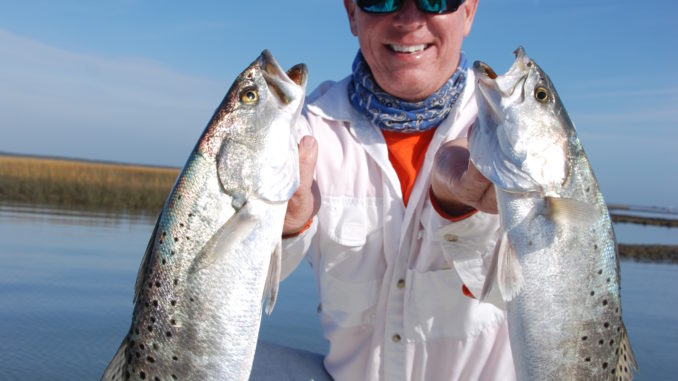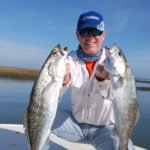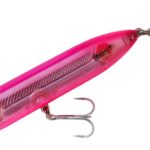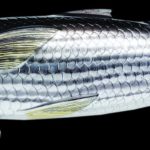
The Carolinas’ coast is full of speckled trout this month, and there’s no way more fun to catch them than on topwater lures.
It’s a fact: everyone likes catching fish on topwater baits. What makes fishing baits at the surface even better is that at certain times of the year, like October, you can frequently catch bigger fish on topwater lures than anything else.
Many gamefish species — and speckled trout in particular — feed by sight and are especially susceptible to topwater presentations. The baits are only half in the water and present an accurate visual representation of forage. What could be more natural than an appetizing-looking morsel zipping along the surface, throwing caution to the wind and making so much commotion that signals either injury, panic, or both?
The standard that all other topwater baits have been measured against for years, Heddon’s Zara Spook, spun off into a saltwater bait several years ago with several sizes of the Super Spook, which feature a wide variety of both natural and bright, eye-catching color schemes, a beefed-up internal harness system and saltwater hooks. Many anglers hope the hook choice is still a work in progress.
“Change the hooks right out of the package,” advised guide Ricky Kellum of Jacksonville, N.C. “It probably would not be a big problem if you were only catching trout, but one bite from a good-sized drum, and the hooks bend all out of shape. Then, if you bend them back, they tend to snap off.”
Saltwater Spooks come in the 5-inch Super Spook and 3½- inch Super Spook Jr. Both readily catch plenty of trout, but the smaller size typically gets the nod in the Carolinas. Their appeal is a walk-the-dog retrieve that gamefish species find irresistible. The bait zigzags back and forth on the retrieve, with the angler imparting the action. The retrieve begins with a twitch of the rod tip, which makes the lure dart in one direction. A second twitch makes the lure dart in the other direction. A medium-speed twitch-twitch-twitch while reeling up the slack makes the walk-the-dog action. Keeping just a little slack in the line is important to getting more “glide” on each twitch.
LiveTarget’s Mullet Walking Bait takes the walk-the-dog action another step, with a spitting action or “blooping” sound, plus an internal tungsten weight that produces a soft knocking sound during the retrieve.
Gary Abernathy of Asheville, N.C., marketing manager for LiveTarget, said the combination offers the best of both worlds fishing the fall speckled trout run.
“With this bait, you cover three of a fish’s primary senses,” he said. “It’s identically shaped as the bait the trout are feeding on, so it sends out the correct feel in the water. It also produces the sound that mullet make in the water. A lot of baits can do that, but where the disconnect comes in is when the trout, which are sight feeders, get close enough to see the bait.”
Mark Davis of Columbia, S.C., the host of TV’s Big Water Adventures, is a big fan of Bomber’s Saltwater Grade Badonk-A-Donk, and he has a couple of proven tips for anglers targeting trout.
“For big trout, I have two tactics that work everywhere,” said Davis, who has caught lots of big trout. “I start with a big topwater lure, the Badonk-A-Donk. These baits range from 31/2 to 5 inches. I cast these over the top of submerged structure and around visible cover. Change colors and retrieves until you zoom in on the pattern.”
“Rip it as hard as you can two or three times, and then pause for three to 10 seconds,” he said. “The fish usually hit on the pause. Casting this rig allows me to cover a lot of water quickly.”
Davis has found that time of day doesn’t make much difference with big trout. He has caught as many in the middle of the day as morning and evening. He indicated that water clarity will matter in size and color of baits, as trout tend to be color specific from day to day.
“What I mean is, don’t be scared to use any colors — bright or dark — regardless of the water color,” said Davis. “There are no rules with trout. Often, if I’m having a tough day, I’ll try the color I have least confidence in. That’s worked more than once.”





Be the first to comment